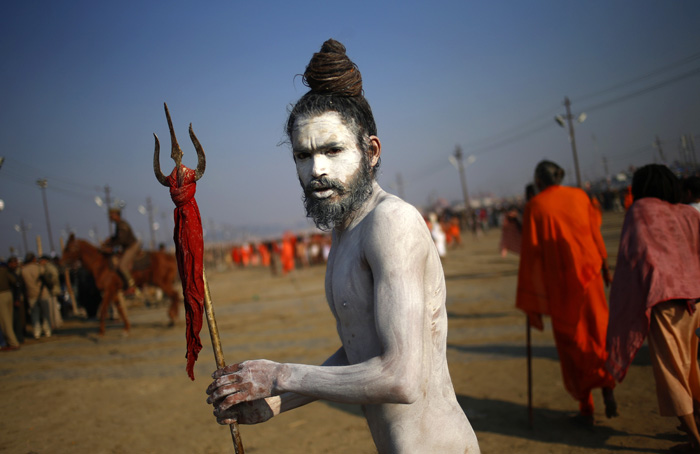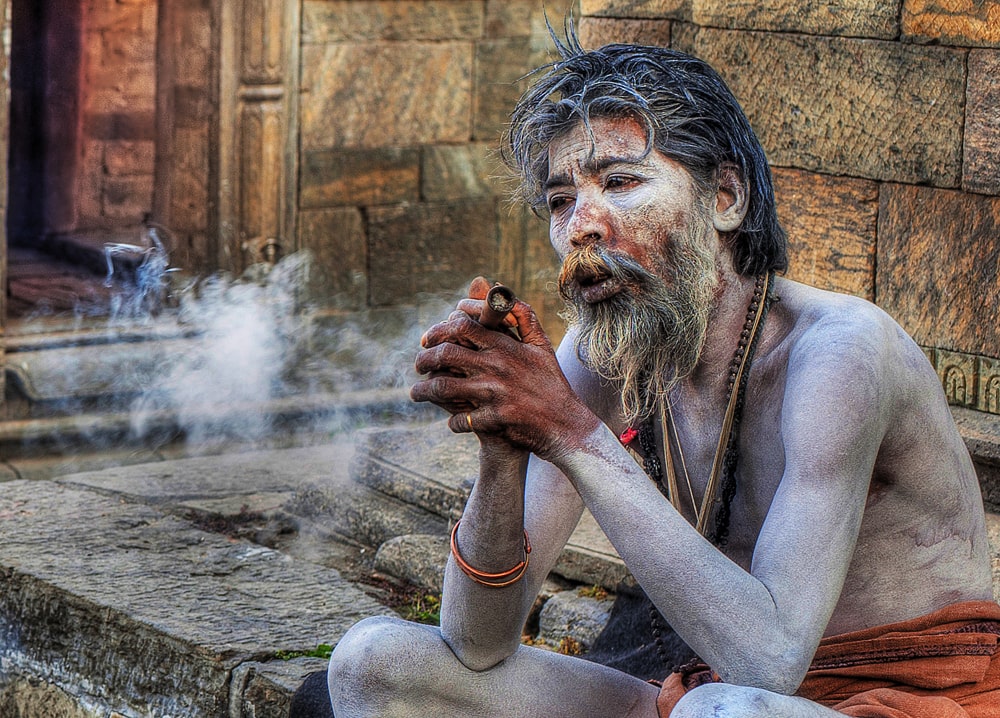
In Hinduism and Jainism, a sadhu (sadhvi for females) is a religious ascetic who has renounced worldly life. Sadhu literally means “a person who practices a sadhana or keenly follows a path of spiritual discipline”. Sadhus are often referred to as yogis or sanyasis. Although the vast majority of sadhus are yogis, not all yogis are sadhus. A sadhu is solely dedicated to achieving moksha (liberation from the cycle of death and rebirth) through meditation and contemplation of Brahman.
There are many types of sadhus in the Hindu religion. Of these are Naga sadhus and Aghori sadhus who are both Shaivites (followers of Lord Shiva). Given their strikingly similar appearance of ash-smeared, unkempt, and naked bodies, they are often mistaken to be of the same sect. While they both have undoubtedly mystical personalities, there are great differences between them, right from their training, beliefs, lifestyles, to their powers.
Naga Sadhus
The Naga sadhus, literally translated as naked sadhus, are devotees of Lord Shiva and believe in the philosophy of becoming Shiva to worship Shiva. They are said to have once functioned as an armed order to protect the Shiv temples and Hindu culture from being erased by the Mughals. Their retreats are still called akhara (armed camps) and mock duels in wrestling and martial arts are often held in the akharas. This is also why they are often seen carrying weapons like swords and trishuls.

Naga sadhus are revered by Hindus as the protectors of Sanatana Dharma. They are one of the most sought-after sights in the Kumbh Mela and a trip to the Kumbh Mela remains incomplete without visiting their camps and hearing them preach. Given their higher state of enlightenment, the Naga Sadhus are bestowed with the honor of taking the first holy dip in the waters (shahi snan) during the Kumbh Mela.
Becoming a Naga Sadhu requires one to live a life of celibacy and 12 years of grueling training in meditation, yoga, and religious rituals. Most Naga sadhus begin their journey in their early teens and perform their last rites, making themselves dead to their families and friends, before immersing themselves in the training process. The male and female Naga Sadhus alike lead a life of abstinence from the pleasures of the body, mind, and material possessions.
Aghori Sadhus
Aghori sadhus are the devotees of Lord Shiva and are regarded as the fifth incarnation of Lord Shiva. They worship Shiva in His most fierce form of Bhairava. The word Aghori in Sanskrit means "fearless" and the Aghoris embody this fearlessness in their existence.
Aghori sadhus believe that every person's soul is Shiva but is chained by eight worldly bonds (astamahapasa) – including sensual pleasure, greed, anger, fear, obsession, and hatred. The practices of the Aghoris are centered around these bonds, upon release of which, the soul becomes sadashiva and obtains moksha.

Aghoris hold sacred the Hindu deity Dattatreya, believed to be an incarnation of Brahma, Vishnu, and Shiva in the same physical body, as a predecessor to the Aghori Tantric tradition. Their sacred text or holy book, Avadhuta Gita mentions that Lord Shiva spent most of his time in cremation grounds doing sadhana and the Aghoris follow this practice as His devotees.
The practices of Aghori sadhus are considered contradictory to orthodox Hinduism and hence the Aghoris are generally opposed by a larger section of the civilized society. However, many Aghori sadhus command great respect and following from rural populations given their supposed healing powers gained through years of tapasya (meditation).
Key Differences between Naga sadhus and Aghori sadhus
1. Initiation
Naga sadhus stay in the Akharas and study vedas, yoga, and traditional martial arts under the tutelage of a Guru. They have to pass difficult stages of training and examinations, often compared to the world’s toughest army preparations, to become a Naga sadhu. In the final stage of becoming a Naga sadhu, one has to stand without food for 24 continuous hours under the Akhada flag during which a dand is kept on his shoulder, hands are made to hold water pots and his phallus (penis) is beaten slowly to destroy his libido completely and make it inactive.
Aghori sadhus too learn under a Guru and perform penance in the crematorium to acquire occult powers. However, there is no formal training or certification required to become an Aghori sadhu as they consider Lord Shiva as their ultimate mentor. It takes about 12 years to become a Naga or Aghori Sadhu.
2. Powers
Naga sadhus meditate and spread their learnings with other seekers, especially during the Kumbh Mela.
Aghori sadhus sit near the cemetery and do penance and gain divine powers during tapasya through which they can also communicate with the souls of dead people. People often regard their practice as sorcery or black magic which the Aghoris claim are simply powers gained due to the prolonged practice of sadhana and tapasya. Aghoris believe that they have a remedy for all human illnesses and use oils from the dead human corpses and make medicines out of them.
3. Practices
Naga sadhus are usually known as warriors and are always ready to fight or wrestle anytime to uphold the ideals of Sanatana Dharma.
Aghoris practice Shav Sadhana, one of the most difficult and secretive rituals of Tantra, in which they sit on a corpse for meditation. After the Shav Sadhna is complete, the Aghoris gain power over the soul of the deceased which increases their supernatural powers. Aghoris also have sexual intercourse with dead bodies (necrophilia) to fulfill the deeper desire of the goddess Kali, and which further increases their supernatural powers.
4. Dwelling
Naga sadhus generally stay in the woods or deserted temples in the Himalayas.
Aghori sadhus stay near cremation grounds or deep jungles in India and Nepal.
5. Attire
Naga sadhus don’t believe in clothing and roam around naked with the ash of sacred fire Dhuni smeared on their bodies.
Most Aghori sadhus too remain naked while some wear some animal skin or cloth to cover the lower part of their body. All Aghori sadhus smear cremation ashes on their bodies and often use human bones for decoration. Aghoris consider little things like tidying up, combing hair up, or covering bodies to be insignificant to achieve omnipotence.
6. Food
Naga sadhus survive on Bhiksha (alms) that is procured from a maximum of seven homes from which if they have not been given any food, must starve for the day.
Aghori sadhus feed on dead human flesh from corpses floating down the river Ganges (never directly off a burning pyre at a ghat). They drink alcohol, smoke marijuana, and occasionally consume human feces. They are often found drinking water from the skull of human bones.
7. Social Interactions:
Naga sadhus come down from the Himalayan plains only during the Kumbh Mela and make themselves available to the Hindu pilgrims seeking instruction or advice in their spiritual lives.
Aghori sadhus generally appear in Ambubachi Mela at the Kamakhya shrine.
As is obvious, both the Naga sadhus and Aghori sadhus greatly differ in their ideologies and often controversial practices. However, they remain united in their objective of achieving liberation from the endless cycle of death and rebirth (moksha), the ultimate goal in Hinduism.
TO READ THE FULL ARTICLE

Get full access to the exciting content on The Mirrority by logging in
Support independent journalism
Even the very best of media houses in our country today are yielding to the pressure of click-bait journalism in order to survive. More than ever before, our country needs journalism that is independent, fair and non-pliant to the bureaucracy. Such journalism needs the support of like-minded readers like you to help us survive editorially and financially.
Whether you live in India or India lives inside you, help us continue to produce quality journalism with your contribution.
CONTRIBUTE
